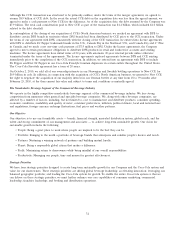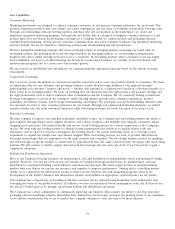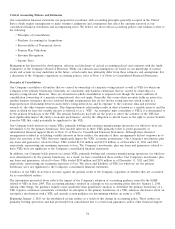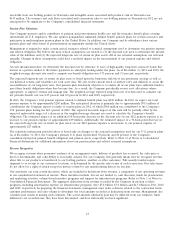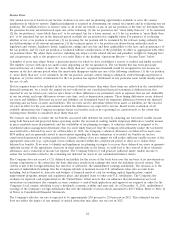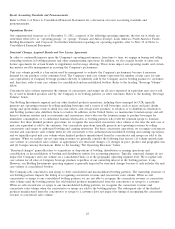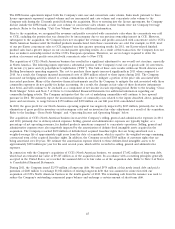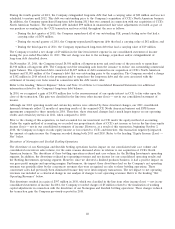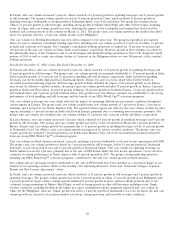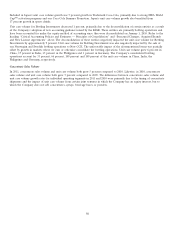Coca Cola 2011 Annual Report Download - page 43
Download and view the complete annual report
Please find page 43 of the 2011 Coca Cola annual report below. You can navigate through the pages in the report by either clicking on the pages listed below, or by using the keyword search tool below to find specific information within the annual report.receivable from our bottling partner in Venezuela and intangible assets associated with products sold in Venezuela was
$147 million. The revenues and cash flows associated with concentrate sales to our bottling partner in Venezuela in 2012 are not
anticipated to be significant to the Company’s consolidated financial statements.
Pension Plan Valuations
Our Company sponsors and/or contributes to pension and postretirement health care and life insurance benefit plans covering
substantially all U.S. employees. We also sponsor nonqualified, unfunded defined benefit pension plans for certain associates and
participate in multi-employer pension plans in the United States. In addition, our Company and its subsidiaries have various
pension plans and other forms of postretirement arrangements outside the United States.
Management is required to make certain critical estimates related to actuarial assumptions used to determine our pension expense
and related obligation. We believe the most critical assumptions are related to (1) the discount rate used to determine the present
value of the liabilities and (2) the expected long-term rate of return on plan assets. All of our actuarial assumptions are reviewed
annually. Changes in these assumptions could have a material impact on the measurement of our pension expense and related
obligation.
At each measurement date, we determine the discount rate by reference to rates of high-quality, long-term corporate bonds that
mature in a pattern similar to the future payments we anticipate making under the plans. As of December 31, 2011 and 2010, the
weighted-average discount rate used to compute our benefit obligation was 4.75 percent and 5.5 percent, respectively.
The expected long-term rate of return on plan assets is based upon the long-term outlook of our investment strategy as well as
our historical returns and volatilities for each asset class. We also review current levels of interest rates and inflation to assess the
reasonableness of our long-term rates. Our pension plan investment objective is to ensure all of our plans have sufficient funds to
meet their benefit obligations when they become due. As a result, the Company periodically revises asset allocations, where
appropriate, to improve returns and manage risk. The weighted-average expected long-term rate of return used to calculate our
net periodic benefit cost was 8.25 percent and 8.0 percent in 2011 and 2010, respectively.
In 2011, the Company’s total pension expense related to defined benefit plans was $249 million. In 2012, we expect our total
pension expense to be approximately $200 million. The anticipated decrease is primarily due to approximately $953 million of
contributions the Company expects to make to various plans in 2012, of which $900 million was contributed to the Company’s
U.S. pension plans during the first quarter of 2012. The expected favorable impact of this item will be partially offset by the
expected unfavorable impact of a decrease in the weighted-average discount rate used to calculate the Company’s benefit
obligation. The estimated impact of an additional 50-basis-point decrease in the discount rate on our 2012 pension expense is an
increase to our pension expense of approximately $39 million. Additionally, the estimated impact of a 50-basis-point decrease in
the expected long-term rate of return on plan assets on our 2012 pension expense is an increase to our pension expense of
approximately $25 million.
The sensitivity information provided above is based only on changes to the actuarial assumptions used for our U.S. pension plans.
As of December 31, 2011, the Company’s primary U.S. plans represented 58 percent and 60 percent of the Company’s
consolidated projected pension benefit obligation and pension assets, respectively. Refer to Note 13 of Notes to Consolidated
Financial Statements for additional information about our pension plans and related actuarial assumptions.
Revenue Recognition
We recognize revenue when persuasive evidence of an arrangement exists, delivery of products has occurred, the sales price is
fixed or determinable, and collectibility is reasonably assured. For our Company, this generally means that we recognize revenue
when title to our products is transferred to our bottling partners, resellers or other customers. Title usually transfers upon
shipment to or receipt at our customers’ locations, as determined by the specific sales terms of each transaction. Our sales terms
do not allow for a right of return except for matters related to any manufacturing defects on our part.
Our customers can earn certain incentives, which are included in deductions from revenue, a component of net operating revenues
in our consolidated statements of income. These incentives include, but are not limited to, cash discounts, funds for promotional
and marketing activities, volume-based incentive programs and support for infrastructure programs. Refer to Note 1 of Notes to
Consolidated Financial Statements. The aggregate deductions from revenue recorded by the Company in relation to these
programs, including amortization expense on infrastructure programs, were $5.8 billion, $5.0 billion and $4.5 billion in 2011, 2010
and 2009, respectively. In preparing the financial statements, management must make estimates related to the contractual terms,
customer performance and sales volume to determine the total amounts recorded as deductions from revenue. Management also
considers past results in making such estimates. The actual amounts ultimately paid may be different from our estimates. Such
differences are recorded once they have been determined, and have historically not been significant.
41


